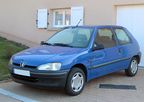Year of Peugeot 106
Peugeot 106 photos, specs - Car Pictures & Images
 The Peugeot 106 is a supermini produced by French automaker Peugeot from 1991 to 2003. It also formed the basis of one of the earliest commercially successful electric cars. The Peugeot 106 was introduced in the autumn of 1991, as the French marque's entry level car slotting in beneath the 205 - although it is now largely considered the 'true' replacement to the 205. It was a substantial development of the Citroën AX. It was heavier, safer, more solid feeling than the AX or 205. It was aimed directly at the Renault Clio which had gone into production a year earlier, and as a more modern alternative to the slightly larger 205 which had been a massive success for Peugeot and was still proving popular almost a decade after its launch. Winning praise for its modern styling, comfortable ride, excellent handling and cheap running costs, the 106 quickly became popular. Going against the appeal were limited interior space and low-rent interior plastics. |
Sales in the UK were strong, with the 106 being the 11th most popular new car in the country in 1993. Its power came from 1.0-litre and 1.1-litre carburettor petrol engines and a 1.4-litre fuel injection unit, as well as a 1.4L Diesel engine which was later dropped in mid/ late 1994 and replaced with a more refined and more economical 1.5-litre unit of 1527cc. A 1.6-litre fuel injected engine was introduced on the 1995 XSi model, with 120 mph (193 km/ h) top speed. In the UK trim levels were basic XN, mid-range XR, top-spec XT, and the sporty XSi model mentioned above. In addition, from 1994 onwards there was a "Rallye" model offered. This was different from the XSi model with the TU2 series 1.3 litre petrol injection engine (100 bhp). This was designed for clubman rallying and the sporting driver, and had little in the way of creature comforts, such as electric windows, power assisted steering etc. On the phase 1 model, a sunroof and anti lock brakes were the only options available from the factory, although many came with foglights or spoilers from the XSi models. In Portugal there was a special edition of 50 units of the Rallye, called R2, which feature extensive use of sporting material from the Peugeot-Talbot racing division which went even further with the extreme nature of the Rallye, with changes to the suspension, brakes, new 14inch speedline rims, racing seatbelts, and engine management and exhaust upgrades to produce 106PS. In early 1996 the Peugeot 106 also formed the basis for the near identical Citroën Saxo, and at this time the 106 received a facelift which saw all engines get fuel injection and equipment levels raised. The XSi was dropped in favour of the new GTi model with a 1.6 16v engine. From 1997-1998 the Phase 2 Rallye was offered, and these combined the light, nimble chassis of the Phase 1 Rallye, with a 1.6 litre petrol injection engine (TU5J2, 103 bhp) and updated looks and safety features of the later models (1996-1999). Optional Extras on the Phase 2 Rallye were; Power assisted steering, airbag and a sunroof. From 1996-1999 trim levels were XN, XL, XR, XT, XS and GTi. In France a five-door version of both XS and GTi versions were offered. » Read More About Peugeot 106 |




